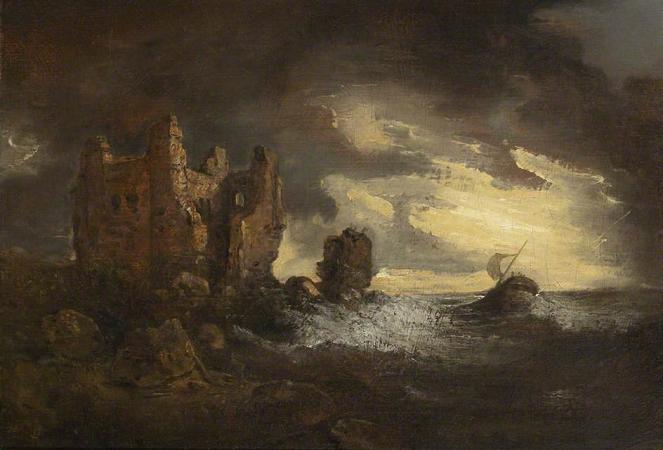John Constable (1776 - 1837). John Constable, was an English landscape painter in the naturalistic tradition. He produced monumental oil paintings primarily depicting the English countryside, revolutionizing landscape art with his distinctive style. Some of his most notable paintings are Hay Wain, Salisbury Cathedral from the Meadows and Dedham Vale. Constable was influenced by artworks such as Jewish Cemetery by Jacob van Ruisdael, Coast Scene with Acis and Galatea by Claude Lorrain, and J.M.W. Turner's early works, particularly in his use of light and atmosphere as evidenced by Cote House (Bristol City Museum). Constable's influence on other artists can be seen in the dramatic lighting of J.M.W. Turner's Fighting Temeraire Tugged to Last Berth, the bold coloring of Eugene Delacroix's Turkish Women Bathing (Wadsworth Atheneum) and the delicate tonal variations of Camille Corot's Italian Landscape (Getty Museum). Constable's influence can also be observed can be seen in many American Hudson River School paintings. These include Thomas Cole's The Oxbow (Metropolitan Museum), Asher Durand's Kindred Spirits (National Gallery of Art, Washington), Fitz Hugh Lane's Gloucester from Dolliver's Neck (Cape Ann Museum) and Frederic Church's Heart of Andes (Metropolitan Museum). Born in Suffolk, he is known principally for his landscape paintings of Dedham Vale, the area surrounding his home-now known as Constable Country-which he invested with an intensity of affection. I should paint my own places best, he wrote to his friend John Fisher in 1821, painting is but another word for feeling. Constable's most famous paintings include Wivenhoe Park of 1816, Dedham Vale of 1802 and The Hay Wain of 1821. Although his paintings are now among the most popular and valuable in British art, he was never financially successful. He became a member of the establishment after he was elected to the Royal Academy at the age of 52. His work was embraced in France, where he sold more than in his native England and inspired the Barbizon school. John Constable was born in East Bergholt, a village on the River Stour in Suffolk, to Golding and Ann Constable. His father was a wealthy corn merchant, owner of Flatford Mill in East Bergholt and, later, Dedham Mill in Essex. Golding Constable owned a small ship, The Telegraph, which he moored at Mistley on the Stour estuary, and used to transport corn to London. He was a cousin of the London tea merchant, Abram Newman. Although Constable was his parents' second son, his older brother was intellectually disabled and John was expected to succeed his father in the business. After a brief period at a boarding school in Lavenham, he was enrolled in a day school in Dedham. Constable worked in the corn business after leaving school, but his younger brother Abram eventually took over the running of the mills. In his youth, Constable embarked on amateur sketching trips in the surrounding Suffolk and Essex countryside, which was to become the subject of a large proportion of his art. These scenes, in his own words, made me a painter, and I am grateful; the sound of water escaping from mill dams etc., willows, old rotten planks, slimy posts, and brickwork, I love such things. He was introduced to George Beaumont, a collector, who showed him his prized Hagar and the Angel by Claude Lorrain, which inspired Constable. Later, while visiting relatives in Middlesex, he was introduced to the professional artist John Thomas Smith, who advised him on painting but also urged him to remain in his father's business rather than take up art professionally.
more...














